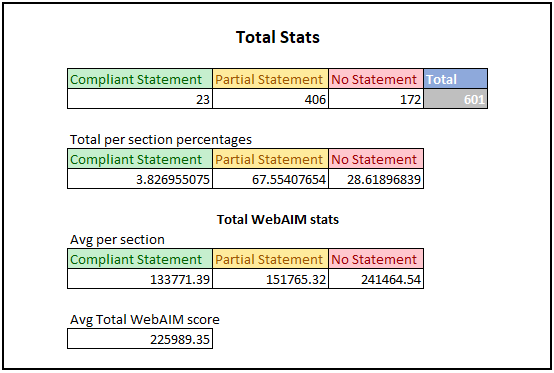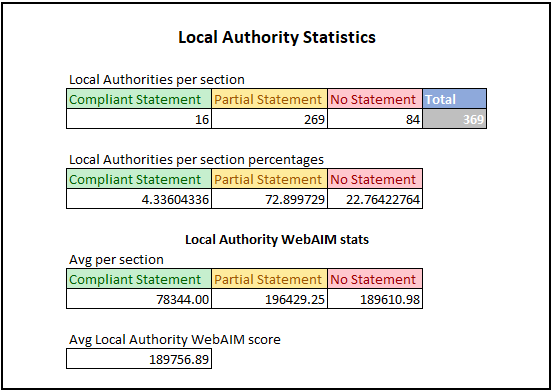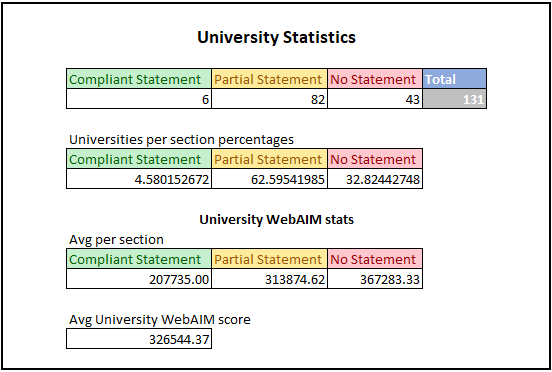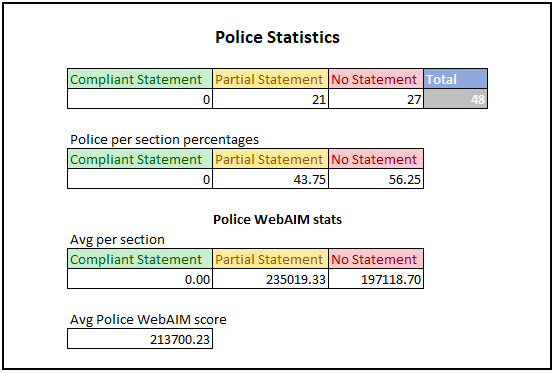We wanted to know more about Accessibility Statements across the UK, how prevalent the adoption of statements was and whether we could then link these findings to other information to create insight.
Some of the questions we had were:
- How many statements are out there?
- What different approaches have been taken?
- Does the presence (and quality) of an accessibility statement correlate with better accessibility?
- Does the dataset indicate levels of awareness for the Public Sector Bodies (Websites and Mobile Applications) Accessibility Regulations 2018?
- Are there geographical areas that are better at statement take up and accessibility overall than others?
To answer some of these questions we have begun compiling a dataset that measures:
- Whether an organisation has an accessibility statement
- Whether the statement is compliant with regulatory requirements
- The websites WebAIM Million rank (The WebAIM million ranks the top million websites on the accessibility of the home page, a lower score is better). This was used to help look at correlation between statement presence and overall accessibility.
- Publicly available email addresses for teams responsible for the statements (This was included as this information has been fed back to GDS in the hope that it supports their ongoing awareness raising campaign).
- Postcodes of main offices to support assessments of ‘geographical hot spots’ of accessibility.
Completed so far
The latest version of the dataset was completed on the 16th September 2019 (however data was collected through late August – early September) and was taken as a pre 23rd September 2019 deadline snapshot of the presence of accessibility statements within Local Government (County and District level), Universities, Police Forces and Fire & Rescue Services.
Overall we looked at 369 Local Authorities, 131 Universities, 48 Police Forces and 53 Fire & Rescue Services for a total of 601 organisations.
Findings
You can download the dataset to look at the information gathered for yourself.
We have also created an online map that has been embedded below for those who may wish to view the information with its geographical component.
Through the basic data we gathered we can identify a few trends and answer some of our original questions below. Firstly the breakdowns of statement compliance overall and per sector. Compliance was broken down into three categories:
- Compliant Statement – A statement that includes the required information per the regulations.
- Partial Statement – A statement exists and ranges from good attempts that is useful but does not fulfil all regulatory requirements to poor attempts that do not provide accurate information and in some cases are misleading to users. (Within the Partial Statement category we have started to distinguish between good and poor attempts but have not yet made this ready for publishing.)
- No Statement – There is no statement present for the website or a blank or single sentence page exists which often belittles the user expectation of accessibility from the organisation.
Overall Results

The above tables show statistics for the overall results of the study. The first table shows number of organisations in each category. For the first table the results are:
- Compliant Statements: 23
- Partial Statements: 406
- No Statements: 172
- Total: 601
The second table shows the percentage breakdown for each section. For the second table the results are:
- Compliant Statements: 3.8%
- Partial Statements 67.6%
- No Statements: 28.6%
The third table shows avg WebAIM Million scores for each section. A lower score in this section is better as it denotes less accessibility issues. For the third table the results are:
- Compliant Statements: 133,771.39
- Partial Statements: 151765.32
- No Statements: 241,464.54
The final figure is the overall WebAIM score for all organisations we looked at. The score was 225,989.35.
Local Authorities Results

The above tables show statistics for the Local Authority results of the study. The first table shows number of organisations in each category. For the first table the results are:
- Compliant Statements: 16
- Partial Statements: 269
- No Statements: 84
- Total: 369
The second table shows the percentage breakdown for each section within Local Authorities. For the second table the results are:
- Compliant Statements: 4.3%
- Partial Statements 72.9%
- No Statements: 22.8%
The third table shows avg WebAIM Million scores for each section within Local Authorities. A lower score in this section is better as it denotes less accessibility issues. For the third table the results are:
- Compliant Statements: 78344
- Partial Statements: 196429.25
- No Statements: 189610.98
The final figure is the overall WebAIM score for Local Authorities we looked at. The score was 189756.89.
University Results

The above tables show statistics for the University results of the study. The first table shows number of organisations in each category. For the first table the results are:
- Compliant Statements: 6
- Partial Statements: 82
- No Statements: 43
- Total: 131
The second table shows the percentage breakdown for each section within Universities. For the second table the results are:
- Compliant Statements: 4.6%
- Partial Statements 62.6%
- No Statements: 32.8%
The third table shows avg WebAIM Million scores for each section within Universities. A lower score in this section is better as it denotes less accessibility issues. For the third table the results are:
- Compliant Statements: 207735
- Partial Statements: 313874.62
- No Statements: 367283.33
The final figure is the overall WebAIM score for Universities we looked at. The score was 326544.37.
Police Forces Results

The above tables show statistics for the Police Forces results of the study. The first table shows number of organisations in each category. For the first table the results are:
- Compliant Statements: 0
- Partial Statements: 21
- No Statements: 27
- Total: 48
The second table shows the percentage breakdown for each section within Police Forces. For the second table the results are:
- Compliant Statements: 0%
- Partial Statements 43.75%
- No Statements: 56.25%
The third table shows avg WebAIM Million scores for each section within Police Forces. A lower score in this section is better as it denotes less accessibility issues. For the third table the results are:
- Compliant Statements: N/A
- Partial Statements: 235019.33
- No Statements: 197118.70
The final figure is the overall WebAIM score for Police Forces we looked at. The score was 213700.23.
Fire & Rescue Services Results

The above tables show statistics for the Fire & Rescue Services results of the study. The first table shows number of organisations in each category. For the first table the results are:
- Compliant Statements: 1
- Partial Statements: 34
- No Statements: 18
- Total: 53
The second table shows the percentage breakdown for each section within Fire & Rescue Services. For the second table the results are:
- Compliant Statements: 1.9%
- Partial Statements 64.1%
- No Statements: 33.96%
The third table shows avg WebAIM Million scores for each section within Fire & Rescue Services. A lower score in this section is better as it denotes less accessibility issues. For the third table the results are:
- Compliant Statements: 576828
- Partial Statements: 226422.53
- No Statements: 249399.5
The final figure is the overall WebAIM score for Fire & Rescue Services we looked at. The score was 240837.45.
Other Findings
We believe that the geographical information is not really relevant to accessibility as the map suggests that there are no distinct clusters of accessibility that can be identified at this time.
Overall awareness of the Public Sector Bodies (Websites and Mobile Applications) Accessibility Regulations 2018 was low with only the compliant worded statements and a few particular good but non-compliant statements mentioning current legislation.
Some of the bad trends we saw throughout the research were:
- Many mentions of Web Content Accessibility Guidelines 1.0 (1999) which have been superseded by later versions.
- Many mentions of browser support for Netscape and IE4 which are long defunct.
- Many mentions of the superseded Disability Discrimination Act (1995).
- Accessibility information often hidden away and very difficult to find.
- Some organisations specifically stating they will not publish a statement, demonstrating clear lack of understanding of their legal requirements.
Up Next
This is only the first iteration of the dataset and we would like to do more with it to further improve our understanding of the UK wide situation. We will be continuing to develop this research, adding more organisations to the list and posting updates when new information is ready.
We plan to update the existing dataset records after the 23rd September 2019 deadline which we hope will give us a demonstrable change in uptake to show.
Sources
For this research we used a number of sources to develop the dataset. For each of the groups we had to find organisational lists. The ones we used are:
- Local Authorities – LGA list of Local Authorities
- Universities – The complete university guide league tables
- Police Forces – Police.UK list of forces
- Fire & Rescue Services – National Fire Chiefs list of Services
For our WebAIM Million results we used the WebAIM Million search tool.
The rest of the results were delivered by manually looking at all of the organisations websites.
Get in touch
This research is not perfect and was completed as a personal endeavour that we gladly share publicly in the hope that it can prove useful to improving accessibility across the UK Public Sector. This work was not commissioned in any way and is not reflective of any organisations’ or individuals’ views on any organisations’ approach to accessibility or regulatory compliance. We fully expect this work to grow outdated quickly as more organisations publish statements.
If you find something in the research that is not quite right we would love to improve so please get in touch using our contact form.
We have already been informed that some organisations have updated their statements during the time the data was being collected and so this may not be an exactly representative picture but are looking forward to updating after the 23rd September.
Find out more
Are you interested in Accessibility Statements? You can find out more along with links to relevant GDS guidance and other organisation’s templates on our Accessibility Statements Page.
If you want to find out more about Digital Accessibility as a wider topic with resources to help you and your organisation improve your accessibility, take a look at our Digital Accessibility Toolkit.
